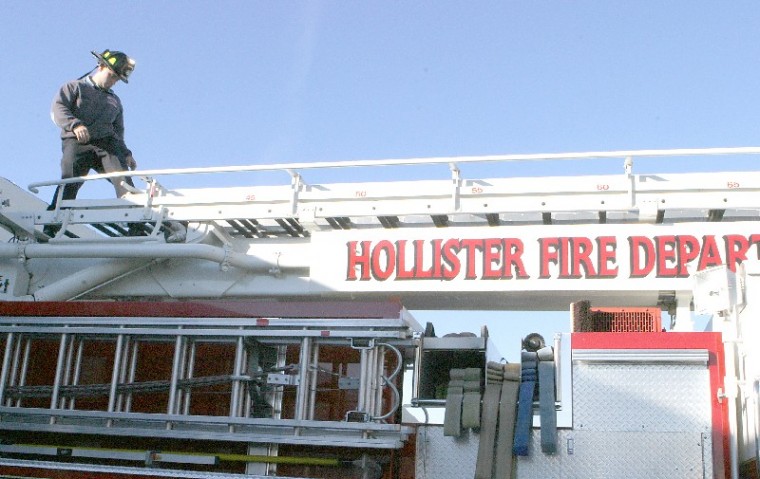
How the failure of Measure R will affect city’s ability to
protect homes and businesses
With the defeat of Measure R
– the 1 percent sales tax that would have increased Hollister
sales tax to 8.25 percent – one of the biggest losers looks to be
the Hollister Fire Department.
How the failure of Measure R will affect city’s ability to protect homes and businesses
With the defeat of Measure R – the 1 percent sales tax that would have increased Hollister sales tax to 8.25 percent – one of the biggest losers looks to be the Hollister Fire Department.
Morale at the department is described as low, but there are consequences facing the broader Hollister community as well.
Since the city faces a shortfall of $2.8 million, an entire laundry list of services must be cut in order to keep the city operating in the black, and fire protection is one of the services threatened, said Councilman Doug Emerson.
A plan that the council developed in October would reduce city hall hours and city offices would be closed on Fridays. Police activities would be severely affected, and the fire department would face some extreme cutbacks as well, including the loss of one truck company; half the paid-call firefighters on staff would be eliminated and the position of fire marshal would also be eliminated.
“I don’t think people realize the difference between a truck company and an engine company,” said Fire Chief Bill Garringer. “The truck company climbs on the roof of the structure and provides support to the people inside the burning structure. They poke holes in the roof and attempt to locate the source of the fire so that the engine company can get inside and search for people who need to be rescued.”
The loss of a truck company, roughly six firefighter positions, affects the other companies since then the engine company is less effective.
“It’s important for people to understand that the truck company mission is vital to the engine company’s success,” Garringer said.
The Hollister fire department is operating at a minimum now, he said. The state dictates that every truck company should have four firefighters and there are three companies, so at a minimum there should be 12 people at a house fire; 14 is optimal. At best the Hollister department has eight people on duty at any given time.
“If we lay off two full-time guys then we’re really in trouble; that’s a huge setback,” Garringer said.
Should fire services be reduced, there is also the possibility that fire insurance rates could increase, according to Don Winn, of Hollister insurance brokerage Winn Insurance. He explained that one of the factors affecting insurance costs is called protection classes. Protection classes are determined by where a structure is located and a fire department’s abilities to respond to a fire.
For example, if a house is located in a wooded area it would likely receive a class 9 designation, reflecting the heightened fire danger; whereas if a house was located downtown – with rapid response times and quick access to water – it would be in a class 3.
If the city shut down part of the fire department, it theoretically could change the capabilities and effectiveness of the department. That could affect the class and consequently costs, Winn said. However, if the department were able to make a case that while services were reduced, the department was not hindered, then the rates would likely remain the same.
For the rating board to reevaluate services, the city would have to request a re-rating, which is not likely.
The position of fire marshal is also on the chopping block. The marshal is responsible for checking sprinkler systems in businesses, coordinating school safety drills and making sure that restaurants maintain fire safety codes at all times.
Should the Hollister City Council go ahead and make the proposed cuts to the fire department Garringer said that there would only be one engine company at each of the three stations in Hollister.
The department has 27 paid and 25 paid-call firefighters (reservists); the reductions would call for the elimination of all the paid-call firefighter positions.
Additionally, for all the 50-plus people working at the fire department there is one administrator and that position is also on the chopping block, Garringer said.
“This department could be stripped completely; it would make it almost impossible to do our job,” Garringer said.
Every department in the city was asked to come up with a contingency plan and this was Garringer’s, but it will ultimately be up to the council to decide how drastic cuts should be.
“I just don’t know if the city has a lot of choices. I came from 29 years in San Jose and I can’t imagine operating without a truck company. I don’t think voters totally understood what they were doing at the time of voting,” Garringer said.
With 35 years of firefighting experience under his belt, Garringer understands the seriousness of having the necessary resources to do a job effectively. He has two employees that are applying to Emergency Medical Technician (EMT) school in Livermore and another that is going through a background check for a job with the Fresno Fire Department.
“The city was not bluffing; now the voters will have to suffer the impacts,” Garringer said.
The council did not discuss the issue at its Nov. 13 meeting, but has plans to discuss the cuts throughout the month of December. As it stands right now, the city staff has until Dec. 1 to put together a new plan for reductions. The council will be presented with the new plan on Dec. 4 and there will be a workshop to discuss reductions at length on Dec. 11. The council will tentatively adopt the reductions on Dec. 18.
It is still unclear when layoffs could actually begin, said City Manager Clint Quilter; the city would first have to meet with employee groups and discuss the situation before they could start layoffs. Quilter said that any action that will take place would not happen until after the first of the year.
Patrick O’Donnell can be reached at po*******@**********ws.com









